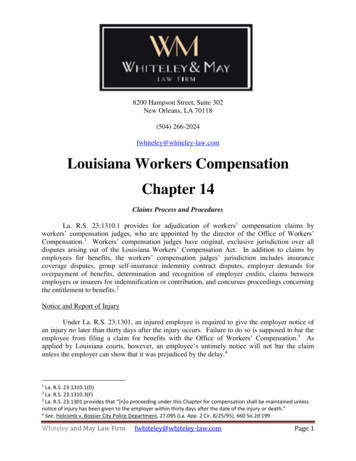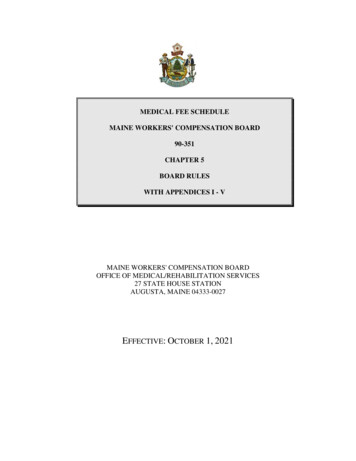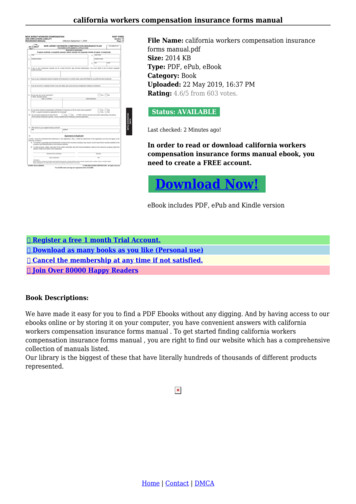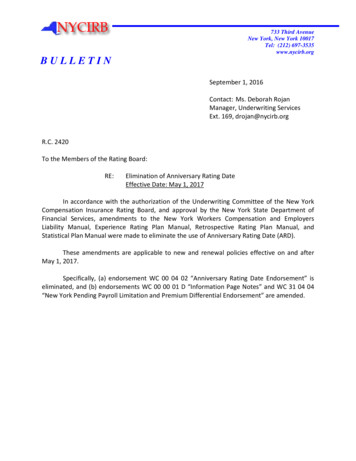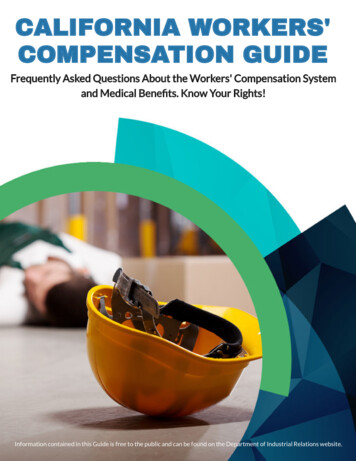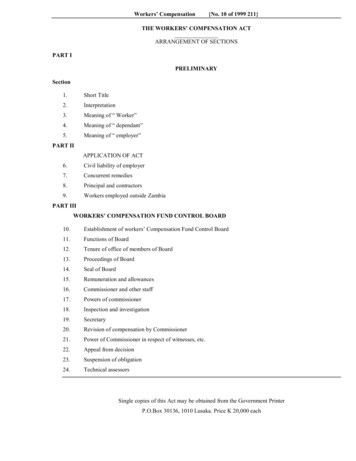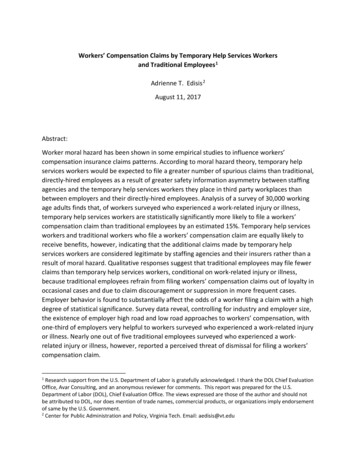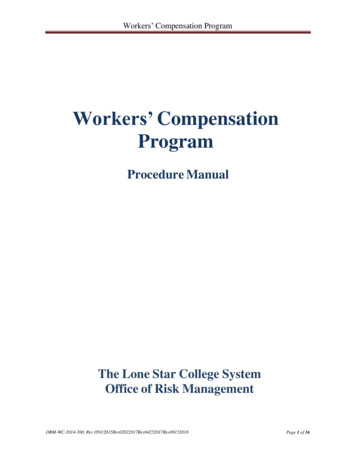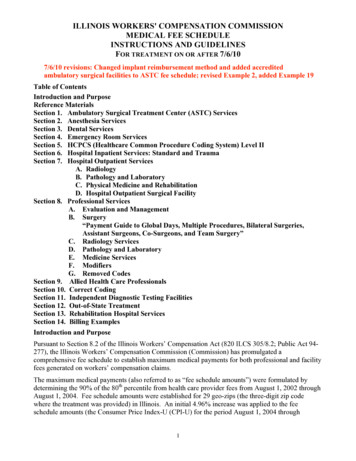
Transcription
ILLINOIS WORKERS' COMPENSATION COMMISSIONMEDICAL FEE SCHEDULEINSTRUCTIONS AND GUIDELINESFOR TREATMENT ON OR AFTER 7/6/107/6/10 revisions: Changed implant reimbursement method and added accreditedambulatory surgical facilities to ASTC fee schedule; revised Example 2, added Example 19Table of ContentsIntroduction and PurposeReference MaterialsSection 1. Ambulatory Surgical Treatment Center (ASTC) ServicesSection 2. Anesthesia ServicesSection 3. Dental ServicesSection 4. Emergency Room ServicesSection 5. HCPCS (Healthcare Common Procedure Coding System) Level IISection 6. Hospital Inpatient Services: Standard and TraumaSection 7. Hospital Outpatient ServicesA. RadiologyB. Pathology and LaboratoryC. Physical Medicine and RehabilitationD. Hospital Outpatient Surgical FacilitySection 8. Professional ServicesA. Evaluation and ManagementB. Surgery“Payment Guide to Global Days, Multiple Procedures, Bilateral Surgeries,Assistant Surgeons, Co-Surgeons, and Team Surgery”C. Radiology ServicesD. Pathology and LaboratoryE. Medicine ServicesF. ModifiersG. Removed CodesSection 9. Allied Health Care ProfessionalsSection 10. Correct CodingSection 11. Independent Diagnostic Testing FacilitiesSection 12. Out-of-State TreatmentSection 13. Rehabilitation Hospital ServicesSection 14. Billing ExamplesIntroduction and PurposePursuant to Section 8.2 of the Illinois Workers’ Compensation Act (820 ILCS 305/8.2; Public Act 94277), the Illinois Workers’ Compensation Commission (Commission) has promulgated acomprehensive fee schedule to establish maximum medical payments for both professional and facilityfees generated on workers’ compensation claims.The maximum medical payments (also referred to as “fee schedule amounts”) were formulated bydetermining the 90% of the 80th percentile from health care provider fees from August 1, 2002 throughAugust 1, 2004. Fee schedule amounts were established for 29 geo-zips (the three-digit zip codewhere the treatment was provided) in Illinois. An initial 4.96% increase was applied to the feeschedule amounts (the Consumer Price Index-U (CPI-U) for the period August 1, 2004 through1
September 30, 2005). The Commission will automatically increase or decrease the maximumallowable payment based upon the CPI-U on an annual basis.In addition to maximum medical payments based upon historical fee data, the Commission has setmaximum medical payment amounts in a manner consistent with Section 8.2 of the Act:1) For entire service categories (e.g., 76% of the charged amount for dental services) or2) For fees within a service category where data was insufficient to establish a fee scheduleamount (e.g., POC76 for a new code).For the purposes of this fee schedule, “POC76” means reimbursement should occur at 76% of thecharged amount.The fee schedule amounts apply only to procedures, treatments, and services provided on or afterFebruary 1, 2006.The fee schedule does not preclude any privately and independently negotiated rates or agreementsbetween a provider and a carrier, or a provider and an employer, that are negotiated for the purposes ofproviding services covered under the Illinois Workers' Compensation Act.This document is intended to assist with fee schedule application, and to insure correct billing andreimbursement on workers’ compensation medical claims. This document is NOT intended, andshould not be construed, as a utilization review guide or practice manual.Reference MaterialsThis schedule is in accordance with the following documents, including codes, guidelines, andmodifiers:1. Current Procedural Terminology, copyright, American Medical Association, 515 N. StateSt., Chicago, IL, 60610, Chicago, 2006.2. HCPCS Level II, U. S. Department of Health and Human Services, Centers for Medicareand Medicaid Services, 7500 Security Boulevard, Baltimore, Maryland, 21244, Baltimore,2006.3. National Correct Coding Policy Manual in Comprehensive Code Sequence for Part BMedicare Carriers, Version 12.0, U. S. Department of Health and Human Services, Centersfor Medicare and Medicaid Services, 7500 Security Boulevard, Baltimore, Maryland,21244, Baltimore, 2006.4. Relative Value Guide, copyright, American Society of Anesthesiologists, 520 NorthNorthwest Highway, Park Ridge, Illinois, 60068-2573, Park Ridge, 2006.5. Diagnosis-Related Group (DRG) classification system, Centers for Medicare and MedicaidServices (CMS), Federal Register, vol. 70, no. 155, August 2005.6. Medicare Severity Diagnosis Related Group (MS-DRG) classification system, Centers forMedicare and Medicaid Services (CMS), 42 CFR 411, 2007.2
Section 1. Ambulatory Surgical Treatment Center ServicesThe Ambulatory Surgical Treatment Center (ASTC) fee schedule provides the maximum medical feeschedule amount for surgical services administered in an ASTC setting for codes 10021 - 69990. TheASTC is a partial global reimbursement schedule1 in that all charges rendered during the operativesession are subject to a single fee schedule amount; however, the following exceptions do exist – theseare the carve-out categories/revenue codes which should be paid as explained in Section 6(C): Prosthetics/orthoticsPacemakerLens implantsImplantsInvestigational devicesDrugs requiring detailed codingCharges billed under the above listed items will be at a provider’s normal rates under its standardchargemaster.For revenue code detail regarding these items, please refer to the “carve-out” information in Section6(C).The ASTC fee schedule shall be subject to Sections 8(B) and 8(F) of this fee schedule; however, onlythe provisions that apply to multiple procedures and bilateral surgeries in 8(B) and applicablemodifiers in 8(F) shall be used.Special note on ASTC radiology, pathology and laboratory charges:The fee schedule amounts listed do not include charges for radiology, pathology and laboratory;therefore, these charges must be submitted under separate claim forms. These charges will be subjectto the professional services fee schedule.This schedule applies to licensed ambulatory surgical treatment centers as defined by the IllinoisDepartment of Public Health and ambulatory surgical treatment facilities accredited by one of thefollowing organizations: American Association for the Accreditation of Ambulatory Surgical Facilities(AAAASF), Joint Commission on Healthcare Organizations (JCAHO), or Accreditation Associationfor Ambulatory Health Care (AAAHC).Section 2. Anesthesia ServicesAn anesthesia fee schedule has been established using historical charge data from August 1, 2002through August 1, 2004. The historical charge data was analyzed and formulated to establish a“conversion factor.” The American Medical Association (AMA) and the American Society ofAnesthesiologists (ASA) are both responsible for developing anesthesia codes and guidelines. Theconversion factor is to be used in manner consistent with guidelines from these two organizations.Specifically, a conversion factor is a dollar amount that is to be used within the context of the 2006Relative Value Guide.1Aside from the carve-outs discussed below, the ASTC does not cover radiology, pathology and laboratory charges thatwould be covered under the HOSF fee schedule. Due to the fact that ASTCs do not normally charge for these categories,charges associated with revenue codes 300 to 359 were removed from the raw database prior to calculating the fee scheduleamounts.3
A. General GuidelinesAnesthesia time begins when an anesthesiologist OR certified registered nurse anesthetist (CRNA)physically starts to prepare the patient for the induction of anesthesia in the operating room (or itsequivalent) and ends when the anesthesiologist is no longer in constant attendance (when thepatient is safely put under postoperative supervision).B. Base value, physical status modifier, time units, and qualifying circumstancesThe maximum fee schedule reimbursement amount for anesthesia services is determined by thefollowing formula:Base Value Time Units Modifying Units Total UnitsTotal Units X Conversion Factor Total Fee1. All anesthesia services reported using CPT codes 00100-01999 have an assigned Base Valueunit(s) (e.g., 00632 7 units). The base value represents the value of all usual anesthesiaservices administered during the service EXCEPT time and modifying factors.The usual anesthesia services included in the base value includes the usual pre- andpostoperative visits, administration of fluids and/or blood products incident to the anesthesiacare, and interruption of non-invasive monitoring (ECG, temperature, blood pressure, oximetry,capnography, and mass spectrometry). The placement of arterial central venous and pulmonaryatrially catheters or the use of transesophageal echo cardiography (TEE) are not included in thebase unit value.2. All anesthesia services are reported by use of the anesthesia 5-digit procedure codes, plus theaddition of a Physical Status Modifier. These modifying units may be added to the basevalues. The use of other optional modifiers may be appropriate. The unit values for thephysical status modifiers are as follows:Unit Values P1 – Healthy patient . P2 – Mild systemic disease . P3 – Severe systemic disease . . P4 – Severe systemic disease—constant threat to life P5 – Moribund patient . P6 – Brain-dead patient/organ donor .0012303. Time Units are calculated by allowing 1.0 unit for each segment of time as is customary in thelocal area (e.g., 1.0 unit for each 15 minutes of anesthesia time).4. In addition to unit amounts established by considering the base value units and time units,additional unit values may be established by reporting extraordinary circumstances (e.g., totalbody hypothermia). These are referred to as Qualifying Circumstances. QualifyingCircumstances are always reported in addition to the base value units, using the followingcodes:4
CPT Code and DescriptionUnit Values 99100 Extreme age . . 99116 Utilization of total body hypothermia . 99135 Utilization of controlled hypotension . 99140 Emergency conditions (specify) . . 1552Example for calculating a fee schedule reimbursement amount in geozip 606Procedure CPT 01744:Time of Anesthesia Services:Physical Status:Qualifying Circumstances:Anesthesia for open or surgical arthroscopic procedures--elbow1 hour 15 minutesP1NoneTranslation:Base Value for 01744Time (75 minutes divided by 15) Physical Status (P1) Qualifying Circumstances-none (0 units)Total Units 5 units5 units0 units 0 units10 unitsFee Schedule CalculationTotal Units10 UnitsFee Schedule Conversion Factor (for geo-zip 606) X 92.99Maximum Fee Schedule Amount 929.90C. Special Coding SituationsSpecial coding situations such as those involving multiple procedures, additional procedures,unusual monitoring, prolonged physician services, postoperative pain management, monitored(stand-by anesthesia), invasive anesthesia and chronic pain management services requireapplication of the fee schedule in a manner consistent with guidelines of the ASA.Section 3. Dental ServicesAll dental fees shall be paid at 76% of charged amount unless the service is billed under codes listed inthis fee schedule (e.g., CPT or HCPCS).Section 4. Emergency Room ServicesAll emergency room facility fees shall be paid at 76% of charged amounts unless otherwise addressedin this section.This fee schedule will apply to all facility fees from any department or facility of a hospital, whethersituated on or off the main hospital campus, that: (1) is licensed by the State as an emergency room oremergency department, and: (2) is held out to the public as providing care for emergency medicalconditions without requiring an appointment; or during its previous calendar year, has provided at leastone-third of all its outpatient visits for the treatment of emergency medical conditions on an urgentbasis.All emergency room facility bills are subject to the radiology, pathology & laboratory and physicalmedicine and rehabilitation fee schedule provisions listed in Section 7.5
Please note that surgical procedures (and all related charges) performed during an emergency roomencounter are exempt from Section 7(D) Hospital Outpatient Surgical Facility fee schedule provisions.Please consult the “Special note on emergency room cases” provision found in Section 7(D) for furtherclarification.Emergency room physicians, billing for professional services and using their own Tax ID number, aresubject to the professional services fee schedule; however, if the professional services are billed by thehospital facility using the facility’s Tax ID number, then these charges are to be paid at 76% of thecharged amount.Section 5. HCPCS (Healthcare Common Procedure Coding System) Level IIThe fee schedule will incorporate the HCPCS (Healthcare Common Procedure Coding System) LevelII codes and modifiers not included in CPT.Section 6. Hospital Inpatient Services: Standard and TraumaThe coding mechanism upon which the inpatient fee schedules are based is that of DRG (diagnosisrelated group). A DRG is a code that groups patients into homogeneous classifications thatdemonstrate similar length-of-stay patterns and use of hospital resources.Two hospital inpatient fee schedules have been established using historical charge data (minus chargedata from eight revenue codes). The first fee schedule is the standard DRG fee schedule that willapply to the vast majority of hospital inpatient bills. The second fee schedule is the trauma DRG feeschedule that will apply to a small number of inpatient bills that involve trauma admissions atdesignated trauma centers.General Guidelines for Standard Inpatient and Trauma Inpatient CareA. Definition of InpatientInpatient care shall be defined as when a patient is admitted to a hospital where services include,but are not limited to, bed and board, nursing services, diagnostic or therapeutic services, andmedical or surgical services. Observation stays are reimbursed under the outpatient schedule.B. Clearly Identifiable DRGAs reimbursement is based upon DRG, hospital providers must clearly identify the DRG in amanner consistent with this fee schedule. The DRG assignment will be made in a mannerconsistent with grouping practices used by the hospital when billing both government and privatecarriers (e.g., CMS Grouper Version 24.0). Hospitals shall list the DRG code on the UB-04.C. DRG as a Global Reimbursement and Revenue Code Exceptions to Global ReimbursementThe DRG fee schedule amount reflects the maximum medical fee schedule amount for an entireinpatient hospital stay.There are, however, eight exceptions: 0274 (prosthetics/orthotics)0275 (pacemaker)0276 (lens implants)6
0278 (implants)0540 and 545 (ambulance)0624 (investigational devices)0636 (drugs requiring detailed coding)These charges are classified as “pass-through” or “carve-out” charges. These revenue codes willnot be covered under the DRG fee schedule amount. Once pass-through charges are identified andremoved, all remaining charges are subject to the DRG fee schedule amount.Non-implantable devices or supplies listed above shall be reimbursed at 65% of actual charge (theprovider's normal rates under its standard chargemaster). A standard chargemaster is the provider'slist of charges for procedures, services and supplies used to bill payers in a consistent manner.Implants within the carve-out revenue codes/categories or implants otherwise identified by anyindividual or grouped revenue codes/categories are to be reimbursed at 25% above the netmanufacturer’s invoice price less rebates, plus actual reasonable and customary shipping charges,whether or not the implant charge is submitted by a provider in conjunction with a bill for all otherservices associated with the implant, submitted by a provider on a separate claim form, submittedby a distributor, or submitted by the manufacturer of the implant.If the fee schedule amount defaults to 76% of charged amount, these rules will still apply. Removeall charges from the applicable revenue code line items and pay as explained above: the remainingtotal charges will then be paid at 76%.D. Cost OutliersThe Illinois Workers' Compensation Act recognizes that there are cases where the costs for treatingan injured worker are unusually high in relation to other patients treated within the same assignedDRG. This fee schedule will use the following formula to determine if cost outlier paymentsshould be made. If, after subtracting the pass-through revenue code charges, the balance of the billis at least two times the fee schedule amount, the charged amount meets the definition of a costoutlier. The maximum fee schedule amount will be as follows: the pass-through revenue codecharges are reimbursed as explained in Section 6(C) and the balance of the bill will be reimbursedat the fee schedule amount plus 76% of the portion of the charges that exceed the fee scheduleamount. The pass-through revenue code charges shall be billed at the provider’s normal ratesunder its standard chargemaster.E. Professional Services Performed in Conjunction with Other Services Associated with theHospitalizationCharges for professional services performed in conjunction with charges for other servicesassociated with the hospitalization and billed by a hospital on a UB-04/CMS 1450 or a 1500 claimform (billing form established by Centers for Medicare and Medicaid Services for use byphysicians) using the hospital's own tax identification number shall be reimbursed at 76% of actualcharge in addition to the amount listed in this schedule for the assigned surgical code. Health careprofessionals who perform services and bill for services using their own tax identification numberon a separate claim form shall be subject to the HCPCS Level II schedule in subsection (h)(5) orthe professional services schedule in subsection (h)(8).Special Guidelines for Trauma Inpatient CareSection 8.2 of the Illinois Workers’ Compensation Act specifically refers to “trauma,” and the IWCCaddresses this section with the Trauma Inpatient Fee Schedule. All inpatient hospital bills from statedesignated Level I and Level II trauma centers (as designated by the Illinois Department of Public7
Health) and which contain an admission type of “5” on the UB-04 FL142 are subject to the TraumaInpatient Fee Schedule (not the standard fee schedule).All trauma admissions are subject to the same rules discussed in this section.Section 7. Hospital Outpatient ServicesThe Illinois Department of Public Health defines a hospital as any institution, place, building or agencyrequired to be licensed pursuant to the Hospital Licensing Act [210 ILCS 85].No fees submitted from a hospital for outpatient services will be subject to the professional services orHCPCS fee schedules.This schedule includes radiology, pathology and laboratory, physical medicine and rehabilitation aswell as scheduled surgical services performed in a hospital outpatient setting that were not performedduring an emergency room encounter or inpatient hospital admission. The radiology, pathology andlaboratory and physical medicine and rehabilitation schedules shall be applied to the number of unitsbilled on the UB-04.A. RadiologyThe hospital outpatient radiology fee schedule provides the maximum medical fee schedule amountfor radiological services performed (in a hospital outpatient setting) for codes 70010 – 79999. Thismaximum medical fee schedule amount is for the technical component of radiological servicesprovided in this setting, and billed in conjunction with revenue codes 320 to 359, 400 through 409and 610 through 619. This schedule does not apply when the bill type requires the application ofthe hospital inpatient DRG fee schedule, or hospital outpatient surgical facility fee schedule. Thisfee schedule will apply to all other hospital outpatient settings including emergency room visits.Note: Professional radiological services billed by a hospital, and using the hospital’s Tax IDnumber are to be paid at 76% of the charged amount. Professional radiological services billed byradiologists or radiology groups using their own Tax ID number (even though the technicalcomponent is performed in a hospital setting), are subject to the professional services fee schedule.B. Pathology and LaboratoryThe hospital outpatient pathology and laboratory fee schedule provides the maximum medical feeschedule amount for pathology and laboratory services performed (in a hospital outpatient setting)for codes 80048-89356. This maximum medical fee schedule amount is for the technicalcomponent of pathology and laboratory services provided in this setting, and billed in conjunctionwith revenue codes 300-319. This schedule does not apply when the bill type requires theapplication of the hospital inpatient DRG fee schedule, or hospital outpatient surgical facility feeschedule. This fee schedule will apply to all other hospital outpatient settings including emergencyroom visits.Note: Professional services in this area billed by a hospital and using the hospital’s Tax ID numberare to be paid at 76% of the charged amount. Professional pathology services rendered bypathologists or pathology groups using their own Tax ID number (even though the technicalcomponent is performed in a hospital setting) are subject to the professional services fee schedule.2UB-04 refers to uniform billing form used by hospitals. “FL” is the acronym for “form locator” and the number thatimmediately follows it indicates where on the UB-04 billing form the CPT/HCPCS and revenue codes are listed.8
C. Physical Medicine and RehabilitationThe hospital outpatient physical medicine and rehabilitation fee schedule provides the maximummedical fee schedule amount for physical therapy services performed (in a hospital outpatientsetting) for codes 97001-97799. This maximum medical fee schedule amount is for all physicaland occupational therapy services in the aforementioned code range and in conjunction withrevenue codes 420-439. This schedule does not apply when the bill type requires the application ofthe hospital inpatient DRG fee schedule, or hospital outpatient surgical facility fee schedule. Thisfee schedule will apply to all other hospital outpatient settings including emergency room visits.D. Hospital Outpatient Surgical FacilityThe Hospital Outpatient Surgical Facility (HOSF) fee schedule provides the maximum medical feeschedule amount for surgical services administered (in a hospital outpatient setting) for codes10021 - 69990. The Illinois Department of Public Health defines a hospital as any institution,place, building or agency required to be licensed pursuant to the Hospital Licensing Act [210 ILCS85]. The HOSF fee schedule is a global reimbursement schedule in that all charges/line itemsrendered during the operative session are subject to a single fee schedule amount; however, thefollowing exceptions do exist – these are the carve-out categories/revenue codes, which should bepaid as explained in Section 6(C). Except for the carve-out/revenue codes listed below, this feeschedule shall not be applied on a line item basis. 0274 (prosthetics/orthotics)0275 (pacemaker)0276 (lens implants)0278 (implants)0540 and 545 (ambulance)0624 (investigational devices)0636 (drugs requiring detailed coding)Charges billed under the above listed revenue codes shall be at a provider’s normal rates under itsstandard chargemaster.The HOSF fee schedule shall be subject to Sections 8(B) and 8(F) of this fee schedule; however,only the provisions that apply to multiple procedures and bilateral surgeries in 8(B) and applicablemodifiers in 8(F) shall be used.Special note on emergency room cases:Surgical sessions initiated as part of an emergency room visit (bills containing revenue codes 450 to459) are not subject to the HOSF fee schedule. Emergency room bills not subject to the HOSF feeschedule are still subject to the hospital outpatient services radiology, pathology and laboratory, andphysical medicine/rehabilitation fee schedules. All other emergency room charges shall be paid at76% of the charged amount.When an outpatient surgical procedure is not recognized/found in the HOSF fee schedule, all chargesare to be paid at 76% of the charged amount subject to the 65% carve-out categories discussed above.When professional services (e.g., CRNA services) are billed by a hospital in conjunction with the othercharges associated with the scheduled surgery, using the facility’s Tax ID number, whether billed on aUB-04 or on a separate 1500 claim form, these charges will be removed and paid at 76% of thecharged amount. No fees submitted from a hospital for outpatient services will be subject to theprofessional services or HCPCS fee schedules.9
E.Cost OutliersThe Illinois Workers' Compensation Act recognizes that there are cases where the costs for treating aninjured worker are unusually high in relation to other patients treated with the same procedure code(s).This fee schedule will use the following formula to determine if cost outlier payments should be madefor outpatient surgical facility charges. If, after subtracting the pass-through revenue code charges, thebalance of the bill is at least two times the fee schedule amount, the charged amount meets thedefinition of a cost outlier. The maximum fee schedule amount will be as follows: the pass-throughrevenue code charges are reimbursed as explained in Section 6(C) and the balance of the bill will bereimbursed at the fee schedule amount plus 76% of the portion of the charges that exceed the feeschedule amount. The pass-through revenue code charges shall be billed at the provider’s normal ratesunder its standard chargemaster.Section 8. Professional ServicesThe fee schedule for professional services is based on the American Medical Association CurrentProcedural Terminology (CPT) code set.A.Evaluation and ManagementThe fee schedule defers to the guides and descriptions in the CPT in establishing the correctclassification of evaluation and management services (codes 99201-99499).ModifiersModifiers for evaluation and management include, but are not limited to: 21, 22, 24, 25, 32, 52, 53,57, and 59. See the modifier chart below or refer to the CPT for further information.B. SurgeryPlease refer to the table, “Payment Guide to Global Days, Multiple Procedures, Bilateral Surgeries,Assistant Surgeons, Co-Surgeons, and Team Surgery,” when determining global days and whendetermining which codes support applying modifiers for multiple procedures, bilateral surgeries,assistant surgeons, co-surgeons, and team surgery.C. Radiology ServicesThe fee schedule provides three categories of maximum medical reimbursement for radiologycodes 70010-79999:1) Total component (sometimes referred to as “global”);2) Professional component; and3) Technical component.When a charge is submitted by one physician who provides both the technical and professionalcomponents of a radiology procedure, designated by no attached modifier, the maximum medicalreimbursement will be the amount listed in the “TOTAL” column.When a charge is submitted for a physician’s interpretation and report on radiology procedure, orother professional services related to that procedure, as designated by the -26 modifier, themaximum medical reimbursement will be that listed in the “PC AMOUNT” column of the feeschedule.When a charge is submitted for only the technical component (costs associated with equipment,supplies, technical personnel etc.), as designated by a –TC modifier, the maximum medicalreimbursement will be that listed in the “TC AMOUNT” column. Note: The TC modifier is not10
found in the CPT book, but it is a modifier for “technical component” found in HCPCS Level II.The fee schedule recognizes and instructs the use of the –TC modifier when billing for thetechnical component of a radiology procedure.Default InstructionsWhen the fee schedule defaults to POC76 in the “TOTAL” column, the amount paid will be 76%of the total charge. The professional and technical components will be paid at 76% of the chargedamount. (e.g., for modifier 26 - professional component, pay 76% of charged amount; for modifierTC - technical component, pay 76% of charged amount).ModifiersAside from modifiers 26 and TC for the professional and technical components, other modifiers forradiology include, but are not limited to: 22, 52, 59, 76, and 77. See the modifier chart below orrefer to the CPT for further information.D. Pathology and LaboratoryThe fee schedule provides three categories of maximum medical reimbursement for pathology andlaboratory CPT codes 80048-89356:1) A total fee for a service that is a combination of the technical and professional components;2) A professional component for when a pathologist provides an opinion on, or reviews testresults; and3) A technical component.When a charge is submitted by one physician who provides both the technical and professionalcomponents of a pathology or laboratory, designated by no attached modifier, the maximummedical reimbursement will be the amount listed in the “TOTAL” column.When a charge is submitted for a physician’s interpretation of a test or procedure, or otherprofessional services related to that test or procedure, as designated by the -26 modifier, themaximum medical reimbursement will be that listed in the “PC AMOUNT” column of the feeschedule.When a charge is submitted for only the technical component, as designated by a –TC modifier, themaximum medical reimbursement will be that listed in the “TC AMOUNT” column. Note: TheTC modifier is not found in the CPT book, but it is a modifier for “technical component” found inHCPCS Level II. The fee schedule recognizes and instructs the use of the –TC modifier whenbilling for the technical component of a pathology or laboratory procedure.Default InstructionsWhen the fee schedule def
Pursuant to Section 8.2 of the Illinois Workers' Compensation Act (820 ILCS 305/8.2; Public Act 94-277), the Illinois Workers' Compensation Commission (Commission) has promulgated a comprehensive fee schedule to establish maximum medical payments for both professional and facility fees generated on workers' compensation claims.
